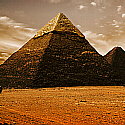Ancient site unearthed in Iraqi home of Abraham
BAGHDAD (AP) — British archaeologists said Thursday they have unearthed a sprawling complex near the ancient city of Ur in southern Iraq, home of the biblical Abraham.
The structure, thought to be about 4,000 years old, probably served as an administrative center for Ur, around the time Abraham would have lived there before leaving for Canaan, according to the Bible.
The compound is near the site of the partially reconstructed Ziggurat, or Sumerian temple, said Stuart Campbell of Manchester University’s Archaeology Department, who led the dig.
“This is a breathtaking find,” Campbell said, because of its unusually large size — roughly the size of a football pitch, or about 80 meters (260 feet) on each side. The archaeologist said complexes of this size and age were rare.
“It appears that it is some sort of public building. It might be an administrative building, it might have religious connections or controlling goods to the city of Ur,” he told The Associated Press in a phone interview from the U.K.
The complex of rooms around a large courtyard was found 20 kilometers (12 miles) from Ur, the last capital of the Sumerian royal dynasties whose civilization flourished 5,000 years ago.
Campbell said one of the artifacts they unearthed was a 9-centimeter (3.5-inch) clay plaque showing a worshipper wearing a long, fringed robe, approaching a sacred site.
Beyond artifacts, the site could reveal the environmental and economic conditions of the region through analysis of plant and animal remains, the archaeological team said in a statement.
The dig began last month when the six-member British team worked with four Iraqi archaeologists to dig in the Tell Khaiber in the southern province of Thi Qar, some 200 miles (320 kilometers) south of Baghdad.
Decades of war and violence have kept international archaeologists away from Iraq, where significant archaeological sites as yet unexplored are located. Still, the dig showed that such collaborative missions could be possible in parts of Iraq that are relatively stable, like its Shiite-dominated south.
Campbell’s team was the first British-led archaeological dig in southern Iraq since the 80s. It was also directed by Manchester University’s Dr. Jane Moon and independent archaeologist Robert Killick.
“This has been an opportunity to get back to an area very close to our heart for a long time,” Campbell said.
Iraq faces a broader problem of protecting its archaeological heritage. Its 12,000 registered archaeological sites are poorly guarded.
___





